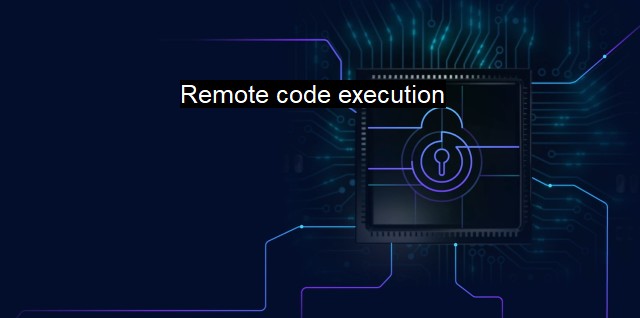What is Remote code execution?
Unleashing the Unthinkable: The Danger of Remote Code Execution (RCE) Exploits in Cybersecurity
Remote Code Execution, frequently abbreviated as RCE, refers to a cyber-attacker's ability to access and make changes on a system, bypassing the limitations of normal system access controls. This security flaw allows an attacker to introduce and execute their software commands from a remote site. Categorized as a severe vulnerability, RCE continues to pose significant threats in Cybersecurity and necessitates robust antivirus protection interventions.In the cybersecurity framework, computers are designed to block external interference, limit unauthorized changes, and safeguard sensitive data. Intruding actors, therefore, need to breach these security measures to access and manipulate a system, which involves exploiting various software vulnerabilities. And among these potential loopholes, Remote Code Execution is considered the most severe, providing elevated privileges to the attackers.
RCE vulnerabilities occur due to programming errors that inadvertently allow external inputs to be processed as system orders. Typically, every software program requires specified inputs to work, such as user credentials or specific commands. if the code running the software doesn't differentiate between regular user data and sensitive system commands, it opens an ever-dangerous security door: the hackers can 'inject' malicious orders into the system masquerading them as run-of-the-mill user inputs.
For instance, an attacker can exploit a weak data-protection infrastructure to tap into a system, introduce harmful commands, and have the computer run the code on its own. This system blind-spot, therefore, affords cyber criminals the capability to take over systems without raising typical security alarms.
The deleterious impacts of Remote Code Execution can vary depending up to what extent an attacker can effectively use the loophole. An attacker with limited access may only cause an inconvenience. But, when an attacker exploits software running as an 'administrator', the damage could be severe with full system control.
Few realize how pervasive and pernicious attacks exploiting RCE vulnerabilities can dramatically impact systems until they arise. The hacker-operated WannaCry ransomware, for instance, exploited an RCE weakness in Windows' systems, thereby affecting well over a quarter-million computers worldwide. The ransomware transpired as Remote Code Execution atop EternalBlue, implying that hackers managed to exploit Microsoft's vulnerability to induce destruction on a colossal scale.
To protect systems from RCE vulnerabilities, a potent cybersecurity strategy is paramount. One of the most crucial elements in this defense arsenal is an effective antivirus program. An antivirus is capable of both detecting RCE vulnerabilities in a system and blocking potential attacks. an effective antivirus should have features such as frequent updates for the latest threats, robust firewalls, encryption capabilities, and a system for proactive scanning and bug detection.
Maintaining an updated and secure system doesn't suffice in isolation, and efforts should complement installing reputable antivirus software and implementing industry-standard security practices. system users can maintain system security by installing updates immediately upon software release, thereby mitigating the risk of RCE vulnerabilities. Recognizing that software updates often include patches for security vulnerabilities can underline the importance of timely software updates.
Cybersecurity practices such as safe internet browsing, downloading reliable software, scrutinizing email attachments, strong password practices, and a strengthened system network could fortify the defense against RCE vulnerabilities.
In the landscape of automated cyber threats, employing counteractive measures can embed a potent system defense system. Therefore, system administrators should opt for constant network monitoring, routine checks, adopting encryption technology, perpetuating risk assessment, vulnerability scanning, and promoting regular awareness training for all system users.
In the face of growing digitalization, Remote Code Execution has set a maze of complex cybersecurity challenges. Hence, the formulation of a robust cybersecurity backdrop, periodic network health checks, user vigilance, regular risk assessment and antivirus incorporation would be instrumental to deter an RCE attack.

Remote code execution FAQs
What is remote code execution?
Remote code execution is a type of cyber attack where an attacker can run arbitrary code or commands on a target system from a remote location.How can remote code execution be prevented?
Remote code execution can be prevented by keeping your software and operating systems up-to-date, using firewalls or network segmentation, and implementing strong access controls and authentication protocols.What are the consequences of a successful remote code execution attack?
The consequences of a successful remote code execution attack can be severe and can include theft of sensitive data, unauthorized access to systems, installation of malware or ransomware, and disruption of business operations.How can antivirus software protect against remote code execution attacks?
Antivirus software can protect against remote code execution attacks by detecting and blocking known vulnerabilities or exploits used by attackers to perform the attack. Antivirus software can also detect and block malicious code that may be executed during the attack.| | A | | | B | | | C | | | D | | | E | | | F | | | G | | | H | | | I | | | J | | | K | | | L | | | M | |
| | N | | | O | | | P | | | Q | | | R | | | S | | | T | | | U | | | V | | | W | | | X | | | Y | | | Z | |
| | 1 | | | 2 | | | 3 | | | 4 | | | 7 | | | 8 | | |||||||